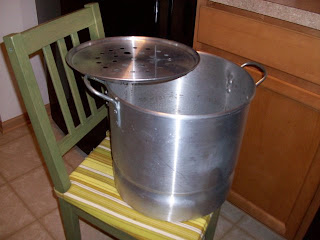Anyway, for Cinco de Mayo, I attempted homemade tamales for the first time. Here's a pictorial account.
First, the ingredients list:
Tamale Filling
1 1/4 lbs. pork shoulder
half a large onion, chopped
2 cloves of garlic, minced
a generous sprinkling of your favorite taco seasoning (I used Penzey's Arizona Dreaming)
Water to cover
Tamale Dough
2 cups masa harina
1 teaspoon baking powder
1/2 teaspoon salt
2 cups water or broth
2/3 cup shortening
And...
about 16 corn husks (I ended up with only 13 tamales but did occasionally double-wrap when the husk wasn't very wide)
Here's the pork shoulder, onion, garlic, and seasoning after cooking all day in the crock pot. Oh yeah.
I shredded the tender pork into smaller pieces and transferred that and all its juices into a little frying pan over medium-high heat so I could boil away most of the water, thickening up the savory liquid and almost caramelizing the meat. In other words, this:
Became this:
While the meat was bubbling away, the corn husks were soaking in warm water. Here, I weighed them down with a plate to keep them submerged, a trick I learned from watching Rick Bayless.
And while the corn husks were soaking while the pork was bubbling, I prepared the tamale dough. First, mix together the masa, baking powder, and salt. By the way, thanks to the large Mexican population of our area, our grocery store carries ingredients such as masa and corn husks in quantities that are not, let's say, novelty size. I have plenty of masa leftover to practice making tamales for a while.
The next step is adding the water to the dry mixture. Use your hands.
Find any little clumps and squish them with your fingers until you have a soft, uniform dough.
In another bowl, beat the shortening until it is fluffy. Then beat in the masa mixture until the dough is spongy. I had the mixer on for less than a minute. I guess the dough seemed spongy.
Drain and rinse the corn husks and lay them out on your work surface. You'll see they naturally curl into little boats. So drop some dough into each boat and spread it about a half-inch thick. I think I had about the right amount of dough in each husk—maybe a little too much in some—but mostly I should have spread it a little wider rather than so thick and right down the center.
Arrange a tablespoon or so of meat down the center of each tamale.
Then roll them up, folding the ends toward the center. I only folded up the bottom (the skinny end of the husk), because I saw on a cooking show that you could steam the tamales with one end open—the top end. And actually, I felt this was easier, because you don't have to worry about finding a way to keep the top edge folded down.
You steam tamales in a tamale steamer, of course. You can use any steamer, really, but we actually have a real tamale steamer. It's the giant pot we use to make our apple butter in the fall. We bought it because it was huge and inexpensive, but it also came with the round, holey insert (appropriately called the steamer insert) you see resting on top of it there. Do you see that indent near the bottom of the pot? Well, that it is where the steamer insert rests inside the pot, and you pour water in to just below that level.
Large as it is, the tamale steamer is meant for the large batches of Christmas or New Year tamales that families often make. My single batch of thirteen tamales didn't even come close to filling all the space in this big pot, but I had to make them stand on end since their tops were open. So I filled the extra space in the pot with something else that can withstand boiling temperature, something we always have around the house.
Success! As I mentioned earlier, I need to improve my dough-spreading, but the pork I cooked was outstanding (especially the leftover bits Len and I ate right out of the pan while the tamales were steaming), and the tamales held together and turned out pretty tasty. Next time, I might also try the fried chile sauce that traditionally goes with the tamales.
















Rick would be so proud!!
ReplyDelete